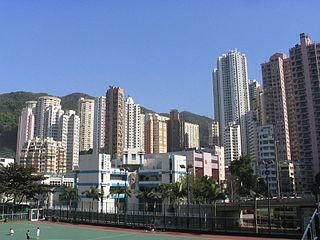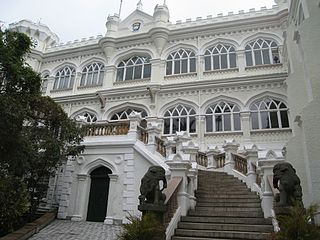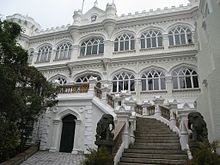
The Hong Kong Academy for Performing Arts (HKAPA) is a provider of tertiary education in Hong Kong. Located near the north coast of Wan Chai on Hong Kong Island, the main campus also functions as a venue for performances. Apart from the main campus in Wan Chai, Bethanie, the site of the institution's Landmark Heritage Campus in Pok Fu Lam, has housed the School of Film and Television since 2007.

Wah Fu Estate is a public housing estate located next to Waterfall Bay, Pok Fu Lam in Hong Kong's Southern District. It was built on a new town concept in 1967 and was renovated in 2003. Divided into Wah Fu (I) Estate and Wah Fu (II) Estate, the whole estate has a total of 18 residential blocks completed between 1967 and 1978.

Pok Fu Lam Road, or Pokfulam Road, is a four-lane road in Hong Kong. Built on Hong Kong Island, the road runs between Sai Ying Pun and Wah Fu, through Pok Fu Lam.

Victoria Road is a main road near the west shore of Hong Kong Island in Hong Kong connecting Kennedy Town and Wah Fu and an alternative connection of Pok Fu Lam Road. It begins north with Belcher's Street in Kennedy Town and goes along Mount Davis, Sandy Bay, Telegraph Bay and Waterfall Bay and reaches in Kellett Bay.

Pok Fu Lam Reservoir, formerly known as the Pokefulum Reservoir, is the first reservoir in Hong Kong. It is located in a valley in Pok Fu Lam. It is actually two reservoirs with capacity of 260,000 m3.

Tai Hang is an area southeast of Causeway Bay located in the mid-north of Hong Kong Island in Hong Kong. It is home to many luxurious private apartments. Residents are predominantly more affluent Hong Kong locals and expatriate professionals.

The Diocese of Hong Kong Island is one of the three dioceses under the Hong Kong Sheng Kung Hui, a province of the Anglican Communion. Its territory covers Hong Kong Island and the outlying islands. The cathedral of the diocese, St. John's Cathedral, is the oldest surviving Western ecclesiastical building in Hong Kong. It was constructed in the 1840s.
The following shows the public housing estates in Pok Fu Lam, Aberdeen, Wong Chuk Hang and Ap Lei Chau of Southern District, Hong Kong.

Béthanie is a historic building complex located in Pok Fu Lam, in Southern District, Hong Kong built in 1875 as a sanatorium by the Paris Foreign Missions Society.

University Hall, or UHall, is a historical residential hall for males at the University of Hong Kong. University Hall is one of the oldest residential halls under the university's hall system and houses about 110 students. Its hall colours are green, black and silver. It is located at 144 Pok Fu Lam Road, close to the Pok Fu Lam Reservoir within the Pok Fu Lam Country Park on the western side of Hong Kong Island.

University, formerly called Mid Levels West before 1994, is one of the 15 constituencies in the Central & Western District of Hong Kong.

Ricci Hall is a hall of residence founded in 1929 by the Society of Jesus in memory of Jesuit Matteo Ricci (1552–1610). Located at 93 Pok Fu Lam Road, Ricci Hall is the only Catholic hostel in The University of Hong Kong. In early 1960, it was decided that space of Ricci Hall was inadequate; it should be renovated and rebuilt. On 8 December 1967, the extension of Ricci Hall was inaugurated.
Kellett School, The British International School in Hong Kong, is an international co-educational school in Hong Kong and member of the Federation of British International Schools in Asia. Founded in 1976, the school's aim is to provide a British style education to students in Hong Kong.
The Fire Dragon Dance in Pok Fu Lam is the main activity during the Mid-Autumn Festival. People hope to beg for peace and be blessed by the gods. It is an important part of the cultural heritage of Hong Kong.

Chi Fu is one of the 17 constituencies in the Southern District, Hong Kong.

Hong Kong Chinese Christian Churches Union Pok Fu Lam Road Cemetery or Hong Kong Chinese Christian Churches Union Pokfulam Road Cemetery is a cemetery in Pok Fu Lam, Hong Kong. It is managed by The Hong Kong Chinese Christian Churches Union (香港華人基督教聯會). It lies on the slopes east of Victoria Road between Tung Wah Coffin Home and Pok Fu Lam Road, facing Sandy Bay.



















